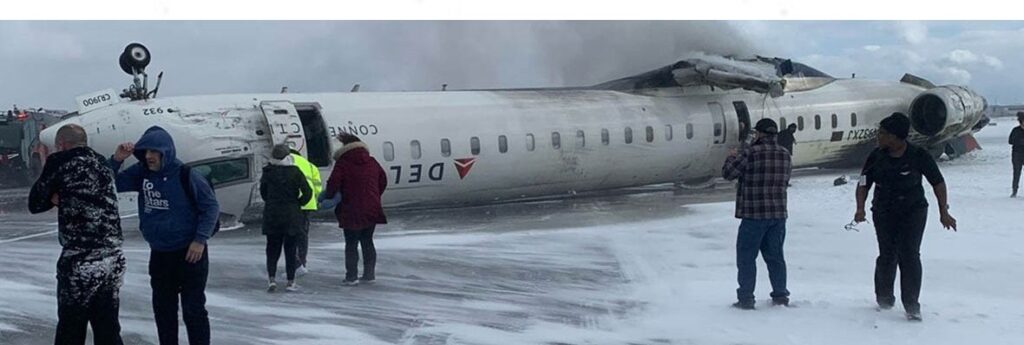A Delta Airlines plane flying from Minneapolis-St. Paul flipped upon arrival at Toronto’s Pearson Airport and ended up on its roof Monday, injuring 17 passengers including three who are in critical condition. The accident happened at about 2:15 p.m. and flights at the airport were grounded for around two and half hours.
Video from the scene shows the Mitsubishi CRJ-900LR upside down on the snowy tarmac as emergency workers hose it down. The plane was somewhat obscured by snow from a winter storm that hit Toronto over the weekend.
Ornge air ambulance said it was transporting one pediatric patient to Toronto’s SickKids hospital and two adults with critical injuries to other hospitals in the city.
“Emergency teams are responding,” the airport said in a post on the social platform X. “All passengers and crew are accounted for.” Seventeen passengers were reported injured.
It is too early to say what caused the plane, which was carrying 76 passengers and four crew, to flip, but weather may have played a factor. According to the Meteorological Service of Canada, the airport was experiencing blowing snow and winds of 51 kph gusting to 65 kph. The temperature was about -8.6 Celsius.
An audio recording from the tower at Toronto Pearson International Airport shows the flight was cleared to land at about 2:10 p.m. local time. The tower warns the pilots of a possible air flow bump in the glide path as the plane comes into land because of a preceding aircraft in front of it.
“It’s very rare to see something like this,” said John Cox, CEO of aviation safety consulting firm Safety Operating Systems in St. Petersburg, Fla. “We’ve seen a couple of cases of takeoffs where airplanes have ended up inverted, but it’s pretty rare.”
Cox, who flew for U.S. Air for 25 years and has worked on NTSB investigations, said the CRJ900 aircraft is a proven aircraft that’s been in service for decades and does a good job of handling inclement weather.
“The weather conditions were windy. The wind was out of the west at 27 to 35 knots, which is about 38 miles an hour. So, it was windy. But the airplanes are designed and certified to handle that. The pilots are trained and experienced to handle that.”
The US Federal Aviation Administration said in a statement that the Transportation Safety Board of Canada would head up the investigation and provide any updates. The National Transportation Safety Board said it is leading a team of US investigators to assist in the Canadian investigation.
Delta said in a statement that “initial reports were that there are no fatalities.”
“Several customers with injuries were transported to area hospitals. Our primary focus is taking care of those impacted,” the airline added.
Endeavor Air, based in Minneapolis, is a subsidiary of Delta Air Lines and the world’s largest operator of CRJ-900 aircraft. The airline operates 130 regional jets on 700 daily flights to over 126 cities in the US, Canada and the Caribbean, according to the company’s website.
The Delta crash is at least the fourth major aviation mishap in North America in the past month. A commercial jetliner and an Army helicopter collided near the Washington, DC, on Jan. 29, killing 67 people. A medical transportation plane crashed in Philadelphia on Jan. 31, killing the six people on board and another person on the ground, and 10 were killed in a plane crash in Alaska.
The CRJ900, a popular regional jet, was developed by Canadian aerospace company Bombardier. It’s in the same family of aircraft as the CRJ700, the type of plane involved in the midair collision near Reagan National Airport on Jan. 29.
If this article was shared with you by a friend or colleague, you may enjoy receiving your own copy of Travel Industry Today with the latest travel news and reviews each weekday morning. It’s absolutely free – just CLICK HERE.

